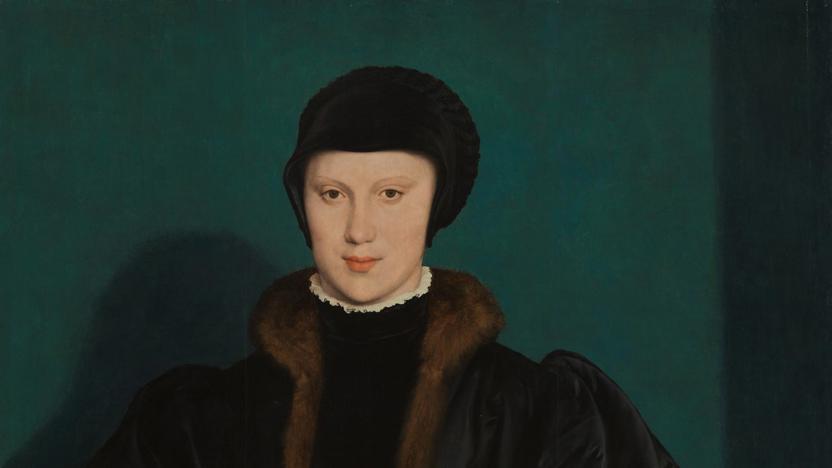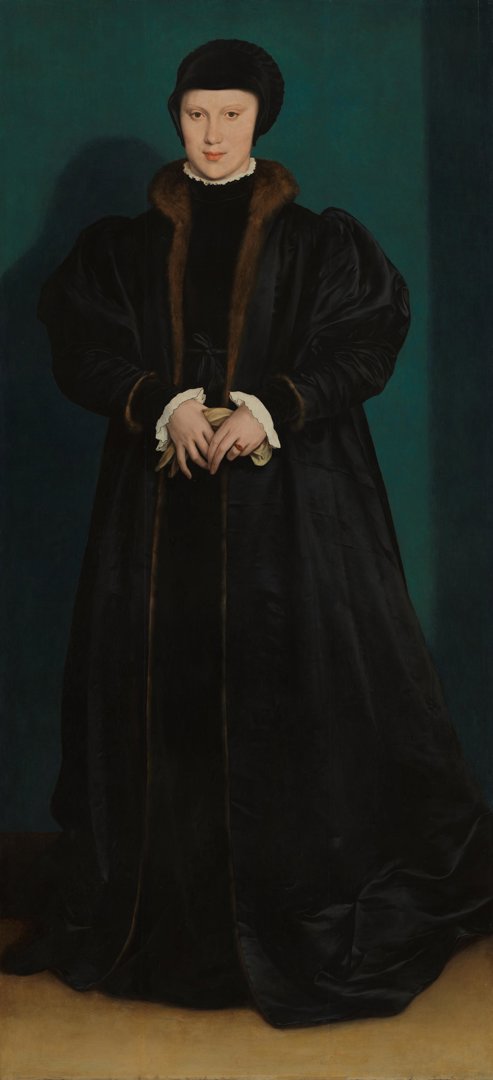Hans Holbein the Younger's 'Christina of Denmark, Duchess of Milan'
Audio description
This is a description of Christina of Denmark painted by Hans Holbein the Younger in 1538. It is oil on oak panel and is 1.8 metres high and just over 80 cm wide. It is in a plain wooden frame.
Sixteen-year-old Christina of Denmark stands full-length, facing us, a blue-green wall behind her. Her figure almost fills the tall rectangle of the painting. There is a pale brown floor underfoot. Dressed entirely in black, only the pale skin of her face and hands is uncovered. Her hair is hidden by a tight fitting cap which encloses her face. It is smooth and calm, with generous, orange-pink lips, a small pointed chin, and dark almond shaped eyes under pale brows. Her hands are clasped in front of her, just below the waist, holding pale leather gloves, and on the fourth finger of her left hand she wears a ring with a red stone.
Her black clothing is made from sumptuous fabrics. She wears a satin coat, that falls in generous folds to the floor, with gathered sleeves that balloon out from her shoulders. The coat is open at the front, where the brown fur lining is visible, as a narrow trim running all the way down to the floor, as well as at the cuffs, and forming a raised collar. Holbein’s incredibly skilled use of oil paint recreates the light catching the smooth folds of black satin, so different from the texture of the fur.
There is a glimpse of her plain black dress beneath the coat, with a high collar, and tied at the waist with a black silk ribbon. A fine white undershirt shows in soft ruffles at the neck and cuffs, edged in a fine black line.
Her figure is in fact very slightly angled to our left, her gown billowing out a little to the right, giving a subtle sense of movement. Bright light falls from top right so her figure casts a shadow on the wall to our left. A narrow band of mysterious shadow runs down the right-hand side of the painting. All these elements give her figure a sculptural, three-dimensional quality, her position in the rectangle of the painting emphasising her height and strong dignified presence.
Despite her youth Christina is in mourning for her husband. She had been married to the Duke of Milan when she was eleven, in 1533. Much older than her, the Duke died two years later and Christina returned to Brussels. She was a member of one of the most powerful families in Europe, the Habsburgs, and therefore a highly desirable bride.
In England Henry 8th’s third wife, Jane Seymour, had died, and he was considering suitable new matches. Unable to visit all potential brides in person he sent his court painter Hans Holbein the Younger to take her likeness in person. Christina sat for him in Brussels for three hours, as she described, while he made drawings. It was important they were accurate rather than flattering, and also full-length, unusual at the time for portraits of women – so that Henry could judge every aspect of her.
Back in London the King was delighted with what he saw and immediately commissioned the painting. However, the marriage plans broke down – luckily some might say for Christina who went on to have an apparently happy marriage as the Duchess of Lorraine. Although Henry married three more times he kept Christina’s portrait till his death.


